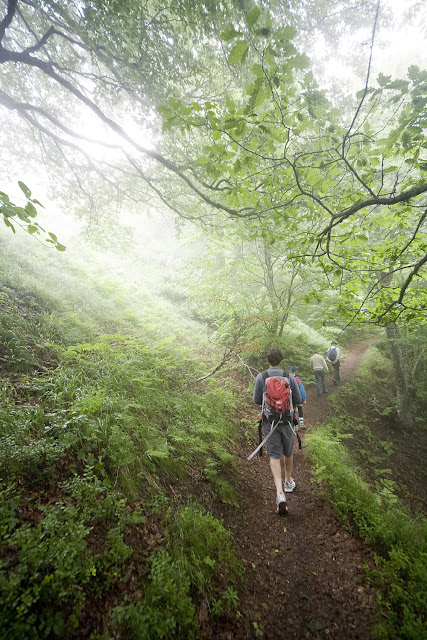I have lived most of my life in Finland, which while not being as flat as the Netherlands, still lacks any considerable mountains. The only hills worthy of mention are in Lapland, a full day's drive away, which means that I'm used to rather more subtle contours of the scenery. However my expectations weren't extremely high, when I moved to the south of France in the spring of 2011, as my perception of the Pyrenees was that is was the homely little brother of the Alps, not really quite worth remarking upon -just a small line in between France and Spain, something to liven up the map a bit.
 |
| The Pyrenees as seen in Pau city center. The prominent peak is pic du Midi D'Ossau. |
Fortunately I was pleasantly surprised almost immediately upon arriving to
Pau, my Hub of existence for the next twelve months. I have to admit that whilst I consider geographically well attuned, I couldn't have placed Pau on the map just five months before arriving. The rather small historical town of Pau lies in the valley of the river Pau, right beside the foothills of the Pyrenees. Even though the town itself looks rather ordinary by French standards (which is to say its town center is rather spectacular and historic from my Finnish point of view), it really stands apart due to the spectacular view of the Pyrenees right at the center of the town. The Pyrenees lie just circa 30 km (ca. 20 miles) south of the town and the highest peaks that mark the border between France and Spain, lie just 50 km south, as the crow flies, or a bit over an hour, as my vehicle of choice lumbers on. The Pyrenees form a saw-toothed ridge that defines the view to the south and the image of which is a regular companion to any tourist brochure to the region. What marks the Pyrenees quite apart from the alps is that being quite a stretch farther south, the climate of the nearby valleys accommodate palm trees and other trappings of the Mediterranean (Actually Pau is a bit closer to the Atlantic).
 |
| The Pyrenees could be seen in the distance from our first apartment. Unfortunately the apartment blocks in the foreground didn't improve the view. |
From the moment I arrived in Pau, I felt a magnetic pull to the snow-capped mountains. On the many clear days that are so common in the region, you could feel that you could touch the peaks if you just stretched your hand far enough. It didn't take too long for me and my wife, Milka, to prepare some portable lunch and plenty of water and hop into our trusted Suzuki (on a good day) Wagon-R and find a suitable spot to drive to on our GPS and see what would lie ahead of us. The problematic thing about tourism in France is that it is rather self-serving and only (mostly) in French, at least anywhere beyond Paris or Euro Disney. So at first we didn't end up in the most spectacular location, but a ski-resort, which was just ending its season and as the skies were cloudy, we ended up just walking around and taking note that even if it's twenty degrees C in the valley, it is still rather cold in the mountains.
 |
| When there's nothing to see in the distance one can always look down to find the most spectacular things. |
After a while decided to try again, this time with an American friend of ours, who hadn't had much chance to travel outside Pau, where she was doing a short language course. We had hoped that the weather would improve a bit, but even in the south of France, the mountain weather can play tricks and we were again shrouded by clouds. The place we had stumbled upon was called Lac de Fabrèges. In the relatively short winter season it is one of the (apparently) smaller skiing resort in the Pyrenees, but acts as a hub for outdoor activities during the rest of the year. As is common for France, the place was rather poorly signed and any place beyond the (already snow-free) ski resort seemed to be practical no mans land. Being the fool-hardy people that we were, we decided not to me intimidated by the intense fog and cloud cover and followed a scenic mini-railroad track along the ridge of the mountain despite the warning of locals. It seems that according to the locals it's foolhardy to walk in the mountains on a cloudy day. Whether or not they had any reason to be worried, we did survive the walk. The crowning moment was when we decided to stray off the railroad track and climb a hill marked only with small painted pebbles, which the French apparently consider to be sufficient signposts. The path wound up to the top of the ridge, where the locals had built a viewing platform. Suffice it to say that the view would have been much more spectacular had we been able to see more than a couple of meters beyond us, but we were rather proud of having conquered our first Pyrenean summit. Well the company was good and the home made falafel I had brought along couldn't have tasted better. Almost as if to remind us that the mountains follow their own will, the clouds parted as we descended and we did manage to see the splendor of the Pyrenees, at least for a brief glimpse.
 |
| Although we really couldn't see anything, just the fact that you couldn't see anything beyond a couple of meters when your on the ridge of a mountain filled us with awe. |
 |
On the way down the clouds parted and we could just about see down to the valley below.
To be continued...
|



















































